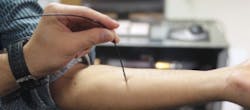Researchers at MIT's Spectroscopy Laboratory (Cambridge, MA) have made a breakthrough in effort to measure blood glucose levels by scanning a patient's arm or finger with light–eliminating the need to draw blood. The near-infrared (NIR) technique was first envisioned by Michael Feld, former MIT professor of physics and Lab director, who passed away this spring. Researchers have been developing the Raman spectroscopy-based technology for about 15 years, and now graduate students Ishan Barman and Chae-Ryon Kong have designed a machine about the size of a laptop computer that could be used in a doctor's office or a patient's home.1
Because NIR light penetrates only about half a millimeter below the skin, it measures glucose in the skin's interstitial fluid–not in blood. So the team devised an algorithm that relates the two concentrations, and lets them predict blood glucose levels from the interstitial fluid's levels.
But interstitial fluid measurements do not always give an accurate picture of what's happening in the bloodstream–for instance, blood glucose soars rapidly right after a patient consumes something sugary, while it takes 5-10 minutes to see a corresponding surge in the interstitial fluid. Barman and Kong's new calibration method, Dynamic Concentration Correction (DCC), accounts for the rate discrepancy.
In a study of 10 healthy volunteers, DCC-calibrated Raman spectroscopy significantly improved the accuracy of blood glucose measurements by an average of 15%, and up to 30% in some subjects.
People have been trying since the 1980s to get optical glucose measurements, says Michael Morris, professor of chemistry at the University of Michigan, who was not involved in the work. He notes that the group appears to have solved a long-standing problem.
A noninvasive blood sugar test could improve the lives of diabetes patients, but Morris says that any such device must be affordable and simple to use. The MIT researchers think that the machine could drive down costs through miniaturization and reduced complexity.
Barman and Kong plan to launch a clinical study to test the DCC algorithm this fall. Barman will receive the Tomas A. Hirschfeld Award for this work at the Federation of Analytical Chemistry and Spectroscopy Societies Conference.
1. I. Barman et al., Anal. Chem. 82 (14): 6104-6114 (2010)
More BioOptics World Current Issue Articles
More BioOptics World Archives Issue Articles
